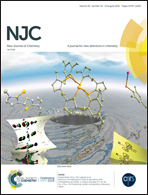Development of an endoplasmic reticulum-targeting fluorescent probe for the imaging of polarity in living cells and tissues†
Abstract
Cell polarity is one of the important parameters of the biological microenvironment and controls the synthesis of functional proteins. As one of the key links in protein synthesis, the endoplasmic reticulum is highly sensitive to the cellular environment and closely related to cell polarity. Herein, we present an ER-targeting fluorescent probe (NSp) for the detection of cell polarity. The probe NSp used naphthalimide as a fluorescent platform and the p-toluenesulfonamide group as an ER targeting group. The red shift of the probe NSp in different solvents can reach 45 nm, and the displacement value in the system of dioxane and water can reach 50 nm. In addition, biological experiments show that the probe NSp shows a difference in the fluorescence intensity of normal cells and cancer cells, and the differentiation between normal cells and cancer cells is successful under conditions of endoplasmic reticulum stress. Besides, the probe can be used to distinguish between normal and cancerous tissues.



 Please wait while we load your content...
Please wait while we load your content...